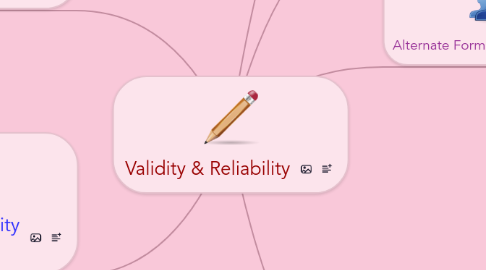
1. Content Validity Evidence
1.1. Established by inspecting test questions
1.2. Do the test questions match the instructional objectives?
1.3. Best for achievements tests
1.4. Yields no numeric value
2. Criterion-Related Validity Evidence
2.1. Two Types
2.1.1. Concurrent Criterion-Related Validity Evidence
2.1.2. Administer new test & established test concurrently
2.1.3. Do students rank similarly on both tests?
2.1.4. Yields a numeric value (validity coefficient)
2.1.5. Predictive Validity Evidence
2.1.6. Predicts future behavior of those being tested
2.1.7. Test-takers are measured on the predicted outcome after a period of time has elapsed & the scores are correlated
2.1.8. Bestfor aptitude tests
2.1.9. Yields numerical value (predictive validity coefficient)
3. Construct Validity Evidence
3.1. No anchoring device to rely on
3.2. Test results correspond to theories/expectations
3.3. Yields many correlation coefficients
4. Test-Retest (Stability)
4.1. Test is given twice & correlation between the scores is determined
4.2. Important to consider the intervals between test administration
4.3. Generally, the longer the interval between tests, the lower the reliability coefficient
5. Alternate Forms (Equivalence)
5.1. Two equivalent/alternate forms of a test are administered & the correlation between the two sets of scores is determined
5.2. Tests must be administered under conditions nearly equivalent as possible
5.3. Problem: It is difficult to develop one good test, let alone two.
6. Internal Consistency
6.1. Internal Consistency
6.1.1. Split-half method
6.1.2. Each item is assigned to one half or the other & the correlation between the two total scores is determined
6.1.3. Essentially, one test is split to make two shorter alternative tests.
6.1.4. Most frequently used method because of its advantages over test-retest and alternate form methods
6.1.5. Kuder-Richardson methods
6.1.6. KR20 Formula
6.1.6.1. Requires% of students passing each item
6.1.6.2. More difficult; Most accurate
6.1.7. KR21 Formula
6.1.7.1. Requires only # of test items, mean of the test and its variance
6.1.7.2. Easier; Slightly less accurate
